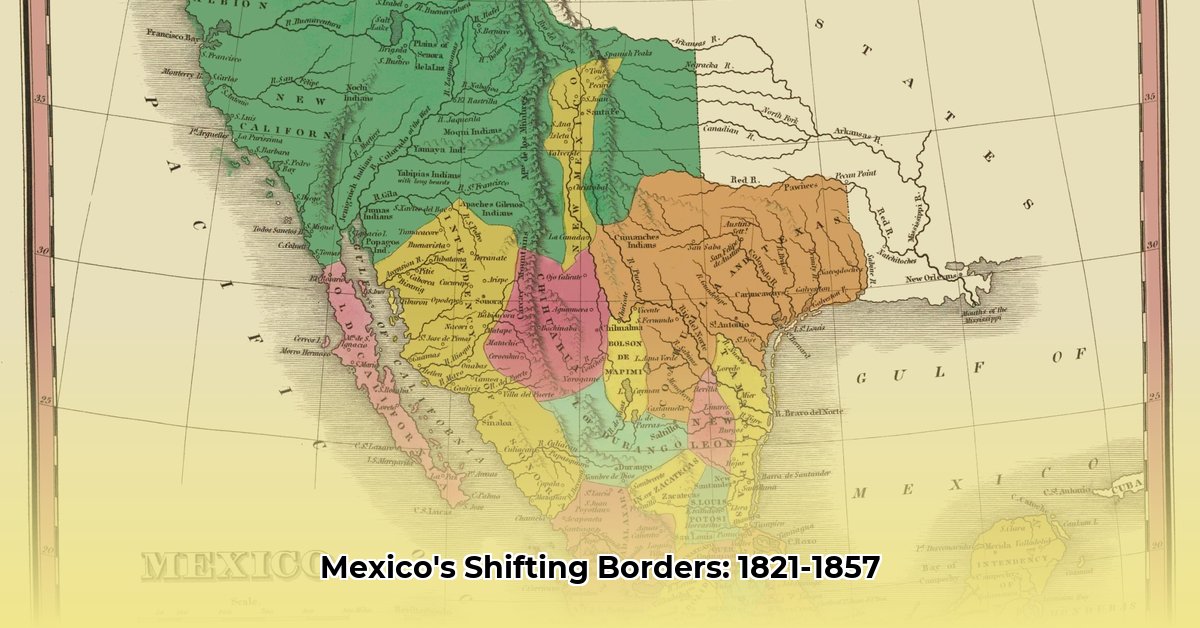Mexico’s borders underwent a dramatic transformation between 1821 and 1857. This era, rife with political instability, internal conflicts, and the looming expansionist ambitions of the United States, witnessed Mexico’s territorial boundaries redrawn repeatedly. This article delves into the complex history of Old Mexico, exploring the key events, political machinations, and lasting consequences that shaped its destiny. For a visual representation of these changes, see this interactive world map.
From Empire to Republic: The Birth of a Nation (1821-1836)
Mexico’s independence from Spain in 1821, while a momentous occasion, ushered in an era of profound uncertainty. The transition from the Viceroyalty of New Spain to a sovereign nation was fraught with challenges. The nascent government, grappling with establishing its authority, faced immediate internal divisions. Federalists, advocating for a decentralized government with strong state powers, clashed with centralists who favored a more consolidated national structure. This power struggle, mirrored in the territorial organization of the country, contributed to instability and made Mexico vulnerable to both internal rebellions and external pressures. The initial euphoria of independence soon gave way to a precarious reality. The very foundations of the new nation were constantly tested. Territorial boundaries shifted as different factions vied for control, foreshadowing future conflicts and losses. The instability of this period undeniably played a significant role in the territorial shifts that would follow.
The Texas Revolution and Its Repercussions (1836-1845)
The Texas Revolution of 1836 marked a pivotal moment in Mexican history and a significant escalation of tensions with the United States. American settlers in Texas, driven by a complex interplay of cultural differences, economic aspirations, and the lure of land, rebelled against Mexican rule. The Mexican government, already weakened by internal strife, struggled to maintain control over the vast and sparsely populated territory. The Battle of the Alamo, a pivotal moment in the conflict, became a symbol of Texan resistance. The decisive Texan victory at the Battle of San Jacinto secured independence and established the Republic of Texas. This loss not only diminished Mexico’s territorial integrity but also fueled resentment and a sense of national vulnerability. The subsequent annexation of Texas by the United States in 1845 further exacerbated tensions and set the stage for a larger conflict. This annexation significantly altered Mexico’s northern border and ignited the spark that led to the Mexican-American War.
The Mexican-American War: A Nation Divided (1846-1848)
The Mexican-American War (1846-1848) proved to be a catastrophic turning point for Mexico. The conflict, rooted in the annexation of Texas and disputes over the border, resulted in a devastating loss of territory. The Treaty of Guadalupe Hidalgo, signed in 1848, forced Mexico to cede vast tracts of land, encompassing present-day California, Nevada, Utah, and parts of Arizona, New Mexico, Colorado, and Wyoming. This represented approximately half of Mexico’s territory. The war, a complex interplay of military campaigns, political maneuvering, and ultimately, Mexican defeat, drastically reshaped the demographics of the region, leading to significant population shifts and the displacement of Mexican communities. The war’s legacy extended beyond territorial loss, impacting Mexican national identity and fostering a sense of injustice that continues to resonate today.
Internal Strife and Shifting Sands (1848-1857)
The aftermath of the Mexican-American War saw Mexico grappling with the consequences of territorial loss and persistent internal instability. The nation was deeply fractured, with regional conflicts and power struggles continuing to undermine its fragile foundation. The Plan of Ayutla, a rebellion against the dictatorship of Antonio López de Santa Anna, exemplified the ongoing struggle for political control. The Reform War, a civil war fought between liberal and conservative factions, further exacerbated the instability. These internal conflicts, often fueled by competition for resources, political power, and ideological differences, led to shifting internal boundaries and administrative reorganizations. The Constitution of 1857, a landmark document that enshrined liberal principles and sought to modernize the nation, emerged from this turbulent period. However, it also deepened the divisions within Mexican society and set the stage for future conflicts.
The Legacy of Loss and Resilience: A Nation Forged in Fire
The period from 1821 to 1857 irrevocably shaped Mexico’s destiny. The dramatic border shifts, driven by a confluence of internal and external forces, left an indelible mark on the nation’s trajectory. The loss of vast territories, the persistent political instability, and the struggles to forge a national identity defined this era. While historical maps provide a visual record of the changing geopolitical landscape, they cannot fully capture the human cost and the complexities of this turbulent period. The legacy of these decades profoundly influenced Mexico’s subsequent history, shaping its relationship with the United States, its internal political dynamics, and its very sense of self. The story of Old Mexico’s borders is a testament to both the fragility of nations and the enduring resilience of a people.
- Mastering Leader in Spanish: The Complete Guide - April 19, 2025
- Uncovering Surprising Parallels: England Size Compared to US States - April 19, 2025
- Old Mexico Map: Border Shifts 1821-1857 - April 19, 2025
















